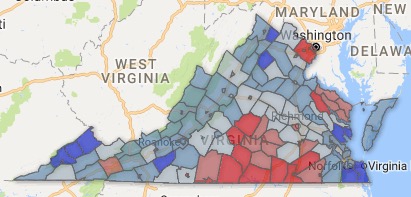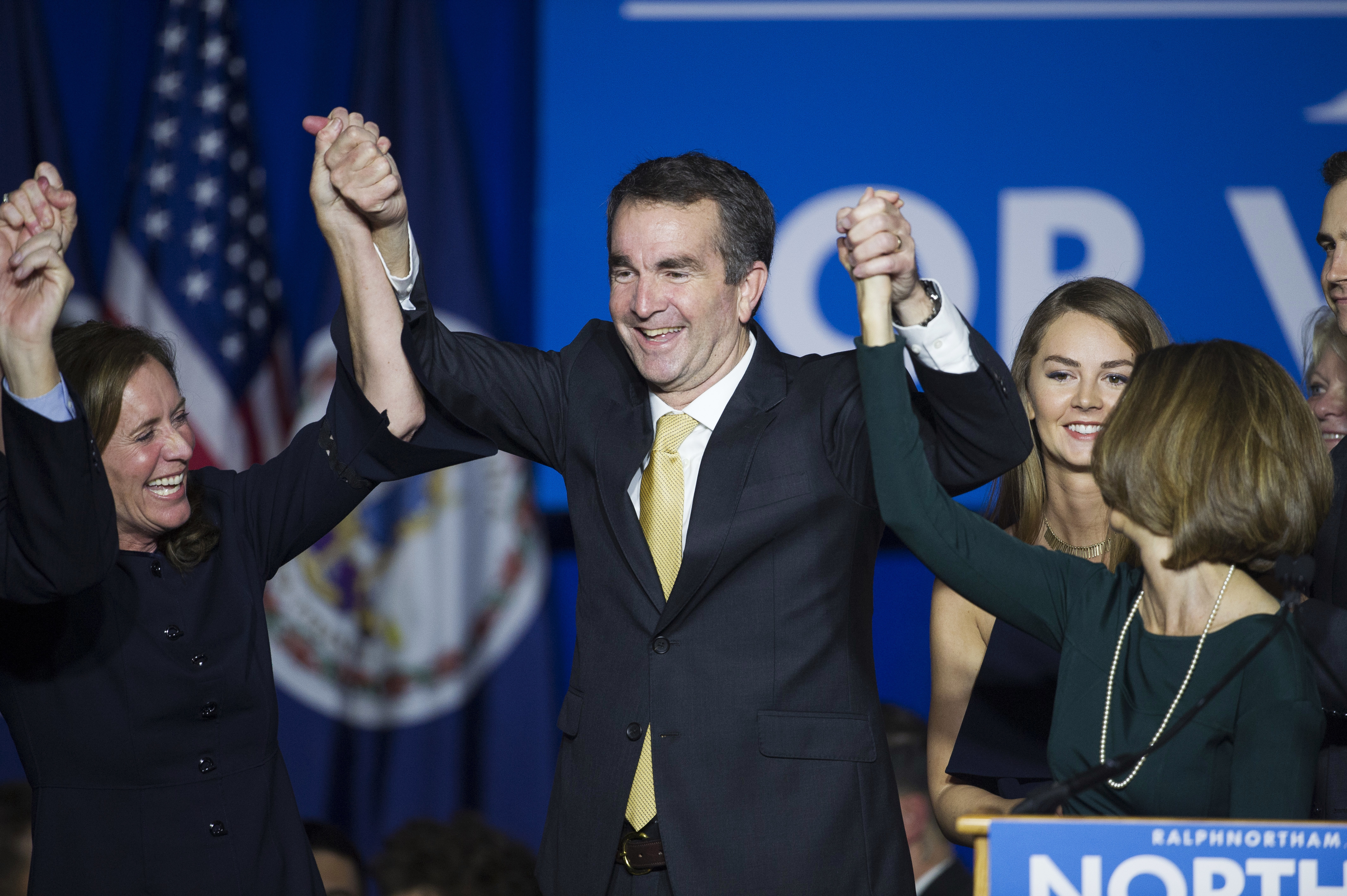Democrat Ralph Northam built his 9-point victory with slight gains over Clinton’s 2016 presidential performance. But rural Virginia is more Republican today than it was during the last governor’s race of 2013.
Political observers are interpreting Democrats’ big wins in Virginia on Tuesday as a repudiation of President Donald Trump, but the results also reveal continued and more entrenched polarization between metro and rural parts of the state.

Republican Ed Gillespie couldn’t quite maintain the eye-popping margins that Trump achieved in rural Virginia in 2016. Gillespie picked up an impressive 72.4 percent of the vote in the state’s remotest counties, but that was about 2 points lower than Trump’s margin in those same counties in 2016.
Gillespie did perform better in rural than Ken Cuccinelli, the GOP’s 2013 gubernatorial candidate.
Democrat Ralph Northam amassed his 9 point victory with small percentage gains in both urban and rural counties compared to 2016 presidential candidate Hillary Clinton. Clinton won Virginia by 5.6 points in the two-party vote. Northam also performed better in suburban and urban Virginia than Democrat Terry McAuliffe, who won the governor’s race in 2013.
Statewide, Northam beat Gillespie 54 percent to 45 percent, an improvement of 4 percentage points on Clinton’s 2016 win and 7 percentage points on McAuliffe’s 2013 victory.
Democrats also won the lieutenant governor and attorney general races, continuing a trend of winning statewide elections — including presidential and U.S. Senate contests — that dates to 2012. Democrats did well in legislative races, too, flipping more than a dozen seats in the 100-member House of Delegates.
Virginia’s rural regions have trended increasingly Republican for the last two decades, accelerating after Barack Obama’s 2008 election and spiking last year, when Donald Trump posted huge numbers in the large swaths of countryside outside metropolitan centers. Trump won the state’s most rural areas by a 74 to 26 point margin in the two-party contest.
One question after 2016 was whether Trump’s rural landslide was merely an outlier, or whether it marked a new normal for partisan divisions. Tuesday’s results suggest it was the latter: in a Democratic wave election, Gillespie came close to matching Trump’s rural margins.
“Rural Virginia, mostly stuck with the GOP brand and backed Gillespie at almost the same levels as Trump,” said Geoffrey Skelley, associate editor of Sabato’s Crystal Ball at the University of Virginia Center for Politics. “However, the problem for the rural areas is that Gillespie didn’t make any inroads in the Urban Crescent, meaning that the more urban and suburban parts of the state trumped the heavily Republican vote in areas such as Southwest Virginia, Southside, and the Shenandoah Valley. This election suggests that the state’s politics may remain very polarized, with urban areas being very Democratic, suburban and exurban areas leaning Democratic, and rural areas voting heavily Republican.”

Compared to 2013’s candidates, Cuccinelli and McAuliffe, Gillespie and Northam represented a political move toward the middle. Both Gillespie and Northam fended off insurgent populist challengers in their respective party primaries.
Gillespie entered the race as a decidedly establishment-friendly candidate, having spent much of his career in Washington, D.C., as a legislative aide, lobbyist and party official. As a strategist, he helped link large GOP donors with the party’s successful efforts to target state legislatures and governors in 2010. Four years later, he nearly upset U.S. Sen. Mark Warner, a former governor who is Virginia’s most popular statewide official, in his 2014 re-election campaign. When Gillespie announced his interest in running for governor, he became the party’s presumptive nominee.
Gillespie’s nomination nearly was thwarted, however, by Corey Stewart, chairman of the Prince William County Board of Supervisors and a Trump-style populist who ran an insurgent campaign based around anti-immigrant policies and defense of Confederate statuary and monuments. Essentially written off by the political establishment, Stewart won big in rural Virginia and came within 4,537 votes, or one quarter of one percentage point, of knocking off Gillespie in a three-way primary race.
During the ensuing general election, Gillespie borrowed substantial elements of Stewart’s campaign in hopes of energizing rural voters. Gillespie campaign ads and mailers attacked Northam for his support of removing Confederate monuments and blamed him for the activity of MS-13, a street gang that the campaign claimed is populated largely by illegal immigrants. Democrats compared the attacks to George H.W. Bush’s “Willie Horton” attack ad against Democrat Michael Dukakis in the 1988 presidential race. For his part, Stewart told the Washington Post he felt “vindicated” by Gillespie’s attacks.
“It feels like my campaign, doesn’t it?” said Stewart, who is gearing up for a 2018 run for the U.S. Senate currently held by Tim Kaine.
At the same time, however, Gillespie largely ignored Trump’s tweets of support. Vice President Mike Pence campaigned for Gillespie in Southwest Virginia, but Trump did not make any appearances for the Republican candidate.
Shortly after Northam was declared the victor, Trump tweeted while on his trip in Asia: “Ed Gillespie worked hard but did not embrace me or what I stand for. Don’t forget, Republicans won 4 out of 4 House seats, and with the economy doing record numbers, we will continue to win, even bigger than before!”
Northam struggled to connect to rural voters. He won his party primary more easily than Gillespie, but still lost much of rural Virginia, especially in the western part of the state. Northam, who grew up in the largely rural Eastern Shore, visited rural Southwest Virginia less than previous Democratic gubernatorial campaigns. After he broke a long-running state political tradition by skipping the Buena Vista Labor Day parade, the chairman of the local Democratic Party there briefly resigned in protest. Northam also was criticized by rural environmental activists for remaining neutral on a pair of proposed natural gas pipelines that were opposed by his primary opponent but endorsed by Gov. Terry McAuliffe, his ticket-mate of four years ago.
On Tuesday, however, Northam won the governor’s race with 53.9 percent of the vote, the most of any Democrat since 1985, when Gerald Baliles won 55.2 percent. That validation of his strategy means that Democrats likely will continue the statewide approach of spending more time and energy on courting metropolitan areas, and less on rural voters.
This article was published by our publishing partner, The Daily Yonder.


